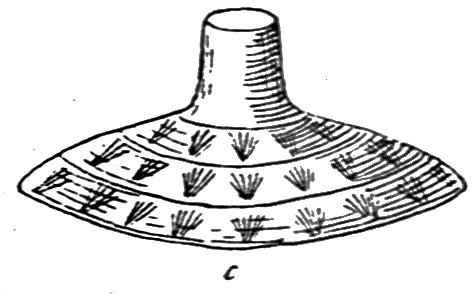The colored graphic illustrating this activity was not part of the original document. The line-drawing graphic was part of the original document. The source page number appears in brackets before the text of that page.

44. Hu-ko-a - Wooden Tops
[Page 221] Wooden or peg tops are so called from hu, top, and ko-a (Acacia koa), the wood of which they are made. They have iron points. A top is put in the middle of a ring on the ground and the object of the game is to knock it out. In New Zealand, according to Taylor1, he pro, he potaka, he kailhora, he kailhotaka, the whipping top, is another game which is played in every part of the island; the top used is more of a [Page 222] cone, and of less diameter than our English one, but in other respects is just the same.
Dieffenbach2 also says that in New Zealand "a top, called kaihora, nicely formed and managed as it is by us, supplies another of their amusements." Codrington3 says: "Tops are made in the Solomon islands of the nut of a palm and a pin of wood, the whole visible length of which, between two and three inches long, is below the head. To spin the top, a double string is wound round the shaft, and the two ends pulled smartly asunder. A similar top was used in Pitcairn island by the half Tahitian children of the Bounty mutineers."
1. Op. Cit., p. 172. 2. Op. Cit., Vol. II, p. 32. 3. Op. cit., p. 342.
43. Hu-o-e-o-e - Humming Tops
[Page 221] Humming tops are made of small gourds. Andrews gives o-ka, "a top made of a small gourd" ; o-kaa, " a top," "to spin like a top"; u-li-li, "a small gourd used for a top to play with" ; and o-ni-u, " a top for spinning, a plaything for children, generally made of a cocoanut."

79. Ki-lu - Gourd Top
[Page 238] A play with a small gourd, which was unknown to my native informants. A specimen in the British Museum (Plate XII, c) is figured in the Ethnographic Album of the Pacific Islands, where it is described as a top played at night in a lascivious game. It is spun through the air at a specific object, the forfeit being at the expense of the woman. Alexander states that the game of ki-lu (and u-me) was always played at night, in an inclosure made for the purpose, and was connected with many vile associations. The ki-lu itself was a [Page 239] small gourd of peculiar shape, which was thrown at a stick set up at a distance.
Andrews gives lo-ha as a kind of sport in former times, the same as ki-lu; also he-lu-ai as the office of a person engaged in the play of ki-lu, and hau-na as the striking of the hand or other substance in playing the ki-lu.
Last update February 3, 2010